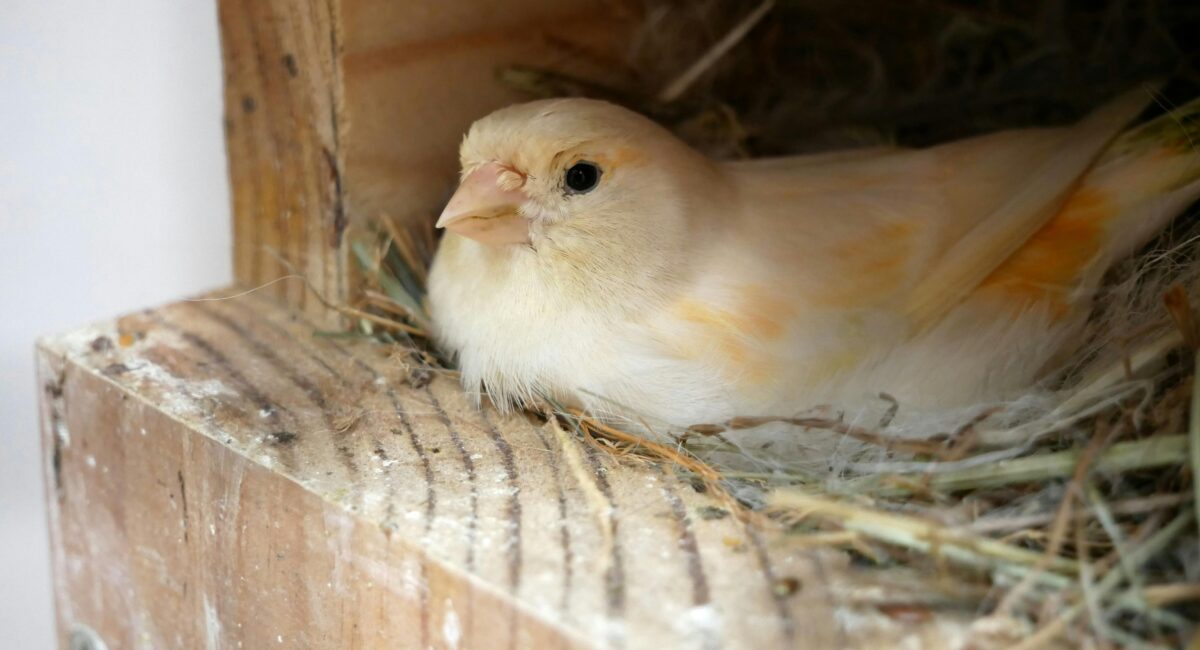What You Need to Know about Breeding Canaries
Breeding Canaries is a very rewarding experience, whether simply enjoying new life, growing and developing, or the bonus of raising & hand-taming your own beautiful, healthy birds. If breeding canaries is a topic that has caught your interest, these are the important facts you must understand to have a memorable and successful birding experience. I know from my own feelings and many years of watching these wonderful birds, I can give you some common tips on what you need to know about breeding canaries.
Choosing the Right Pair
Selecting Healthy Birds
Successful breeding begins with choosing healthy birds. Choose canaries that are:
- Active and Alert: Look for birds that are active and alert.
- Feather Condition: They should have slick, shiny and well-formed feathers, indicating good health.
- Right Age: Canaries should be at least 12 months old before breeding. It’s better not to breed younger birds because they are not physically ready, while older birds may have reduced fertility.
Pair Compatibility
Not every canary species gets along well enough to breed. Before deciding if a male and female canary are good mates, you should first keep them in separate cages near each other for a few days. Spend this time to naturally watch them interact with one another. If interest is apparent (i.e. singing, chirping along the bars, preening through the bars) there is a possibility of compatibility. If you do, it would likely be safer to attempt to pair them with other mates.
Building the Perfect Breeding Environment
Cage Setup
The Surroundings Matter
It actually depends, how you’re going to breed them. If you’re breeding them in a cage, then a sizable cage is crucial to ensure that the pair has enough room to move around freely. The minimum requirement for the breeding cage is 18 inches long by 14 inches wide by 18 inches high. Here’s how to set it up:
- Nesting Materials: Give a nesting basket or box (I prefer to give them a box) with coconut fiber, soft grass, or shredded tissue. The female will construct her nest from these.
- Perches: Provide multiple perches at different levels for movement and exercise.
- Privacy: Place the cage in a quiet, low-traffic area, where your canaries will feel safe, stress-free and undisturbed.
Lighting and Temperature
- Lighting: Increase the hours of light, you can go up to 18 hours during spring. Provide 14-hour light cycles to spur breeding efforts.
- Temperature: Keep it around 65-75°F (18-24°C). Avoid windy and sudden temperature changes.
Nutrition for Successful Breeding
Nutrition is an important factor for breeding canaries. Without proper nutrition, it is hard to imagine successful breeding. You have to pay very close attention to their nutrition and always monitor their daily diet. Here’s what to include:
- Bird Seed Mix: Make sure you have a variety of seeds. There are some seeds that are very high in fat, it’s better to avoid those high fat seeds (my recommendation).
- Egg Food: Breeding birds must be supplied this as an extra source of protein and nutrients. Commercial egg food can be bought or you can mix hard boiled eggs with breadcrumbs or commercial canary food.
- Fresh Fruits & Vegetables: Your canaries should also be able to snack on a variety of fresh fruits (e.g. apple slices, etc) and veggies (e.g. spinach, broccoli).
- Calcium: Keep a cuttlebone or something equivalent for some calcium to the female when she needs it for egg production.
The Breeding Process
Courtship and Mating
After being paired and getting acquainted with a female, the male will eventually start courting her. He will sing louder and advance her his dance. She will crouch low and flutter her wings if she is ready. Mating typically occurs in the early morning.
Nesting and Egg Laying
The female will then begin to collect resources to build the nest. It normally takes just a few days to a week or more. When the nest is ready, she will lay up to one egg per day, usually in the morning, until she completes a clutch of 3-5. After 2-3 eggs are laid, the female will commence incubation.
Incubation and Hatching
The incubation period lasts about 13-14 days. During this time, it’s crucial to:
- Avoid Distractions: Maintain a quiet and happy environment.
- Monitor the Nest: You need to check on the eggs daily, however avoid handling the eggs as well.
Once the chicks hatch, they’ll appear as tiny and very vulnerable. The mother will take care of them, but make sure she has plenty of food and water. This will help her stay healthy and strong so she can look after her babies properly. Keep monitoring them everyday to ensure they all are doing well, and provide any extra support if they needed.
Raising the Chicks
Welcome to the fun fact; this is my most favorite part of monitoring the chicks. I can’t express the feeling of watching the chicks growing up in front of my eyes. But remember the most important part is raising them properly and here are some tips from my side:
Feeding
The mother will feed her chicks for several weeks. Make sure she has a high protein, nutrient dense diet:
- Egg Food: Continue to feed egg food as it is essential for chick development
- Waterlogged Seeds: Soak the seeds for the night to let them be easier for mothers to feed their young ones.
Weaning
Chicks usually experiment with solid food at about 3-4 weeks of age. Provide them with:
- Soft Foods: Provide soft-food items such as soaked seeds and pulpy fruits.
- Fresh Water: Always have fresh water available.
Challenges and Solutions
Breeding canaries can be fun & a rewarding experience, but don’t think about doing it without its challenges. Here are some common issues that you may face and how to work them out:
- Feather Plucking: If you find your canary plucking its own feathers or those of its mate, it may be due to stress, boredom, or nutritional deficiencies. Make sure they feel full, have tons of toys and a downtime place to relax.
- Egg Binding: This is a potentially deadly condition where a female canary is having issues laying eggs. Symptoms are different for this type of blockage – lethargy and straining. If you think your bird may be egg bound go to a vet right away. I prefer not to do it at home, if you don’t have any experience.
- Fighting: Canaries can start fighting with each other, especially in the breeding season. If this occurs, you may need to house them separately for a short while.
- Poor Nesting: If you find your canaries will not make a proper nest, you should supply them with more nesting material, or even a pre-made nest to encourage them.
- Infertility: If your canaries are not producing fertile eggs, it may be that they are old, in poor condition or that the couple is not compatible. Always make sure both birds are healthy and if possible, check in with an avian specialist for best results.
Breeding canaries is a rewarding and fun experience that needs patience, love, and a little information. When you select healthy birds and set up a suitable environment along with the right nutrition it means a successful breeding season. Seeing the chicks mature and evolve is a gratifying trip, one that gives great joy and pride to any canary lover. Well, if you are ready to get started in canary breeding, just follow the tips above and have fun taking care of these beautiful birds.


